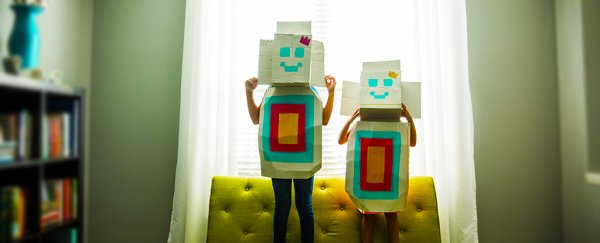There's a chance we're overestimating how much children understand about the minds of others – in fact, we might be expecting too much of kids at too young an age.
For decades now, psychologists have largely agreed that a human child acquires a 'theory of mind' during preschool. Experiments indicate that by age five, most children will generally understand other people are psychological beings with their own desires, intentions, perceptions, and beliefs, both true and false.
Experiments on kids' comprehension of false beliefs in others have been conducted since the 1980s with what's widely known as the Sally-Anne test.
In a typical example, one character (let's name him Maxi) puts a chocolate in a blue box; then, he leaves the room and his mother enters. The observing child watches as the mother takes Maxi's chocolate out of the blue box and puts it in a green box nearby. Then, the mother leaves the room and Maxi re-enters. The observing child is then asked to predict which box Maxi is going to open to look for his chocolate.
For decades, this type of experiment has been repeated over and over, and the findings suggest 90 percent of preschoolers think Maxi is going to open the blue box. Preschoolers seem to know that Maxi is holding a false belief based on what he has seen, as Maxi never witnessed his mother move the chocolate.
But what if we have been misinterpreting these results all along? New data from a decade's worth of false- and true-belief studies in Phoenix, Arizona, conducted among 580 children aged 4 to 7 years, have now challenged the long-held view of many developmental psychologists.
When a third red box is added to the experiment, the results change quite a lot. Researchers have found preschoolers are ultimately torn over which box Maxi will choose, splitting their choice 50/50 between red and blue.
"When there are only two locations, 4- and 5-year-old children can answer correctly without truly understanding that Maxi has a false belief about the location of the chocolate bar," explains psychologist William Fabricius from Arizona State University.
"Adding a third location results in them guessing at chance between the two empty locations."
Preschoolers appear to understand that Maxi does not know the chocolate is in the green box, because he did not see his mother put it there. As far as they are concerned, that leaves the red box or the blue box as Maxi's inevitable 'wrong choice'.
The authors call this thinking perceptual access reasoning, or PAR. While a child understands that seeing leads to knowing, they do not incorporate the memory of Maxi putting the chocolate in the blue box into their answer.
"When there is only one empty location (the blue box), children answer correctly by default," the psychologists explain.
"When there are two empty locations (blue and red boxes), they guess."
And guessing is not equivalent to a deeper understanding of Maxi's motives. No matter whether Maxi holds a false or true belief, new experiments have shown 4- or 5-year-olds struggle to understand his thought process.
For instance, when Maxi leaves the room and his mother doesn't move the chocolate bar, children of preschool age tend to think Maxi will look in the green box, not the blue box where he left the chocolate.
"Perceptual access reasoning users have an immature concept of knowing as tied to the present situation, and do not yet understand that people have memories that persist across situation," explains Fabricius.
"They do not understand that Maxi might remember putting the chocolate bar into the blue box. The evidence from this series of experiments is consistent that children do not understand mental representation until they are 6 or 7 years old."
False-belief studies are considered a gold standard test for theory of mind, but these new experiments suggest these studies might only measure PAR.
If the authors are right and PAR is a precursor to a properly developed theory of mind, then we need to readjust our expectations of preschoolers – and even infants and toddlers – who are said to demonstrate abilities associated with a theory of mind.
Sharing a toy, for instance, requires a child to understand another kid's desires and their current state of mind. So, when a preschooler takes another child's toy, they might not actually understand why the other kid starts to cry.
If an educator knows this, they can rely on a child's capacity for PAR to help each kid understand where the other is coming from.
"We say to the child who is crying, 'I can see you are upset and saw that Johnny took the toy away from you. Is that why you are upset?'" explains Anne Kupfer, director of ASU's Child Study Lab (CSL).
"We then role model and ask the crying child to tell Johnny why they are upset, because he took their toy. Then we direct Johnny to look at the sad child's face and say, 'She just told you she is upset. Why is she upset?' Johnny can then answer, 'Because I took her toy'."
The authors behind the new experiments acknowledge their results will need to be replicated, and further studies will need to explore alternative explanations to PAR.
That said, the pattern of findings has raised important questions about how we have been interpreting one of the most famous experiments in developmental psychology.
The study was published in Monographs of the Society for Research in Child Development.
